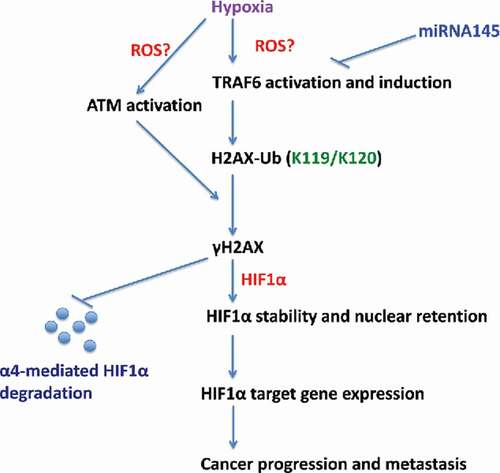HIF-1α/hypoxia signaling regulates diverse biologic processes, such as glycolysis, angiogenesis, and invasion leading to promoting cancer progression, metastasis and therapy resistance.Citation1 Understanding the mechanisms by which HIF-1α/hypoxia signaling is regulated may provide the new paradigms and strategies for cancer therapy and overcoming drug resistance. VHL is a well-characterized E3 ligase component that serves as a critical tumor suppressor by driving HIF-1α ubiquitination and degradation.Citation1 Inactivation of VHL due to the loss of VHL expression or its inactivated mutations is often observed in cancers such as renal carcinomas, rendering HIF-1α accumulation and hypoxia signaling activation to promote cancer phenotypes.Citation1 Since VHL is commonly inactivated and/or lost in advanced cancers, it is technically challenging to develop a good strategy to target VHL for cancer therapy. Therefore, finding druggable regulators that positively maintain HIF-1α stability and nuclear translocation in a VHL-independent manner can provide promising paradigms and strategies for targeting cancers with activation of HIF-1α/hypoxia signaling.
Phosphorylation of H2AX at S139 known as γH2AX occurred during double stranded DNA breaks not only serves as a DNA damage marker, but also plays a critical role in mediating homologous DNA repair.Citation2 H2AX is therefore thought to be a tumor suppressor by maintaining genomic stability.Citation2 Interestingly, hypoxia is known to induce γH2AX formation without causing DNA damage through a mechanism that is yet to be determined.Citation3 Whether or not γH2AX accumulation under a hypoxia challenge plays any role in HIF-1α/hypoxia signaling remains unclear. A recent study from Lin's group has surprisingly revealed a crucial role of γH2AX in HIF-1α/hypoxia signaling.Citation4 γH2AX triggered by active ATM kinase during hypoxia interacts with HIF-1α to maintain its stability and nuclear accumulation, thereby facilitating HIF-1α/hypoxia signaling activation. γH2AX does so by preventing the interaction between HIF-1α and 20S proteasome component α4, in turn promoting expression of hypoxia target genes critical for glycolysis, survival and invasionCitation4 (). While H2AX regulates DNA damage signaling, its role in HIF-1α/hypoxia signaling does not seem to depend on its classical functions in mediating DNA damage response.Citation4
Apart for γH2AX induction, hypoxia also triggers monoubiquitination of H2AX at Lys 119/120, which serves as a critical step for hypoxia-mediated γH2AX formation by recruiting active ATM to H2AX.Citation4 Monoubiquitination of H2AX is initiated by E3 ligase TRAF6, which is induced and activated by hypoxia and plays a crucial role in HIF-1α/hypoxia signaling activation by promoting HIF-1α stability and nuclear accumulation.Citation4 TRAF6 and H2AX are amplified in a variety of cancer types, and TRAF6-mediated γH2AX is significantly correlated with HIF-1α expression and hypoxia gene signatures and predicts poor survival outcome.Citation4 Further study using in vivo mouse tumor models showed that TRAF6-mediated monoubiquitination of H2AX and γH2AX promote breast cancer progression and metastasis.Citation4 This study extends the known role of TRAF6 and H2AX from Akt signaling activationCitation5 and DNA damage signaling,Citation2 respectively, to HIF-1α/hypoxia signaling. Thus, the TRAF6-ATM-H2AX network serves as a novel signaling module critical for HIF-1α/hypoxia signaling and cancer progression and metastasis ().
Several outstanding questions remain to be addressed. Although ATM is activated by hypoxia and is crucial for HIF-1α/hypoxia signaling, it is puzzling about how hypoxia triggers ATM activation since DNA damage is not induced by hypoxia.Citation4 It is likely the induction of reaction oxygen species (ROS) by hypoxia may mediate ATM activation, since hypoxia induces ROS that is known to trigger ATM activation.Citation6 In addition to being activated by cytokines and growth factors,Citation5 TRAF6 E3 ligase is also activated by hypoxia through an unknown mechanism.Citation4 It will be interesting to know whether ROS is also involved in hypoxia-mediated TRAF6 activation. Moreover, as H2AX interacts with HIF-1α, it will be of significance to determine whether H2AX is recruited to the promoter region of HIF-1α target genes and works in concert with HIF-1α to drive expression of HIF-1α target genes. Finally, since HIF-1α/hypoxia signaling drives stemness and drug resistance, it will be critical to determine whether TRAF6-ATM-H2AX signaling network maintains cancer stem cell traits and their self-renewal capability, in turn promoting cancer metastasis and drug resistance. Nevertheless, this new study not only advances our current understanding of HIF-1α/hypoxia signaling regulation, but also offers novel strategies for targeting cancers with elevated HIF-1α/hypoxia signaling. We propose that targeting TRAF6-ATM-H2AX signaling network may be a promise strategy for cancer therapy.
Disclosure of potential conflicts of interest
No potential conflicts of interest were disclosed.
References
- Wilson WR, Hay MP. Targeting hypoxia in cancer therapy. Nat Rev Cancer 2011; 11:393-410; PMID:21606941; http://dx.doi.org/10.1038/nrc3064
- Sulli G, Di Micco R, d'Adda di Fagagna F. Crosstalk between chromatin state and DNA damage response in cellular senescence and cancer. Nat Rev Cancer 2012; 12:709-20; PMID:22952011; http://dx.doi.org/10.1038/nrc3344
- Olcina MM, Grand RJ, Hammond EM. ATM activation in hypoxia - causes and consequences. Mol Cell Oncol 2014; 1:e29903; PMID:27308313; http://dx.doi.org/10.4161/mco.29903
- Rezaeian AH, Li CF, Wu CY, Zhang X, Delacerda J, You MJ, Han F, Cai Z, Jeong YS, Jin G, et al. A hypoxia-responsive TRAF6-ATM-H2AX signalling axis promotes HIF1alpha activation, tumorigenesis and metastasis. Nat Cell Biol 2017; 19:38-51; PMID:27918549; http://dx.doi.org/10.1038/ncb3445
- Yang WL, Wang J, Chan CH, Lee SW, Campos AD, Lamothe B, Hur L, Grabiner BC, Lin X, Darnay BG, et al. The E3 ligase TRAF6 regulates Akt ubiquitination and activation. Science 2009; 325:1134-8; PMID:19713527; http://dx.doi.org/10.1126/science.1175065
- Guo Z, Kozlov S, Lavin MF, Person MD, Paull TT. ATM activation by oxidative stress. Science 2010; 330:517-21; PMID:20966255; http://dx.doi.org/10.1126/science.1192912

